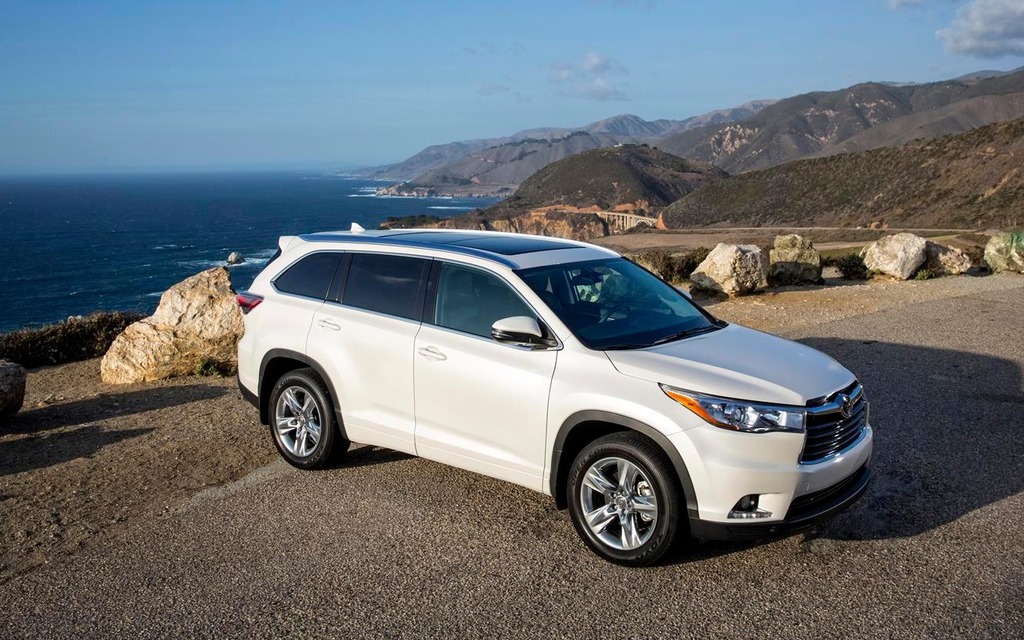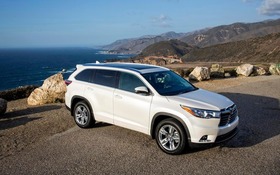2014 Toyota Highlander: Built for Comfort

| Strong points |
|
|---|---|
| Weak points |
|
Carmel, California. When it first hit the market 12 long years ago, the Toyota Highlander struck me as a happy medium between a real SUV and a wagon. But since then, that role has been assigned to the Venza. In a way, it was also a toned-down version of the Lexus RX from the Japanese manufacturer’s line of luxury vehicles.
For 2014, the updated Highlander is running full speed ahead into the intermediate SUV race, where the competition is stiff. Its rivals include the Honda Pilot, Nissan Murano, Ford Edge and even the Chevrolet Equinox and Jeep Grand Cherokee.
To get a leg up, the new edition features a rejuvenated appearance and several enhancements that are sure to put it on par with its competitors. Under the hood, not much has changed. There’s Toyota’s trusty 3.5-litre V6 with 270 horsepower. The four-cylinder engine has been relegated to the history books. The transmission is a six-speed automatic with dynamic torque control. Winter mode helps improve traction on slippery surfaces.
The Highlander’s four trim levels give you the choice of front- or all-wheel drive. The latter of which is handy for tough jobs, but not entirely necessary if you have good winter tires – an option that will save you money at purchase and also at the fuel pump over the years.
Environmentalists have not been forgotten and the Hybrid version (responsible for 30% of the previous model’s sales) is still offered. It is equipped with three electric motors: two in front (one is used as a generator) and the other in back. While the V6’s output is nearLY 200 horsepower, the hybrid system adds another 80, which brings the total 10 ponies ahead of the conventional version. The chassis – the same one found in the Avalon and the Camry – is suspended by MacPherson struts in front while in the rear there is a double-wishbone suspension. The steering and brakes are exactly as before and no one’s going to complain about that.
Toyota’s priority
Let’s make one thing clear: passenger comfort and well-being was the main concern of the Highlander’s designers. The 2014 version is 7 cm longer and 1.5 cm wider, for a more spacious interior overall, especially in the second row (with heated seats, please!). Toyota’s new SUV is also the first eight-seater in its category, with all trims including a third-row bench. But, careful now, this is no place for your mother-in-law or anyone with reduced mobility. Only kids and acrobats will be able to access this bench, where comfort is purely theoretical.
Fortunately, the Highlander compensates with a number of great features, including a power liftgate with adjustable height settings and a window that can be lifted up as needed. There’s also a rear back-up camera as part of the factory-standard equipment, though there’s hardly any need for it, given the excellent visibility. In fact, I would go as far as saying that the Highlander offers the best visibility at all angles compared to any other vehicle on the market, regardless of the category.
Like a car
To make the Highlander handle more like a car than a 4x4 (such as its big brother, the 4Runner), the new Highlander has been lowered by 3 cm. The drop in its centre of gravity improves its road handling substantially. When I tested it on the torturous curves of a West-coast road, I hardly noticed any roll at all. Meanwhile, the steering, despite being power-assisted, is much more precise than the norm in this type of vehicle. And finally, the engine-transmission duo performed splendidly with immediate and energetic responses to any fluctuations of the accelerator. This translated into a certain degree of agility for a vehicle that is all too often ungainly and cumbersome.
The Achilles’ heel of all SUVs is fuel consumption. According to Toyota, the Highlander averages 9.6 L/100 km, which is sure to be impossible to replicate without being extremely vigilant. The optional 19-inch tires that equipped our test vehicle are probably not the best choice if you’re looking for optimum comfort. That said, credit goes to the engine, which is so discreet that you might even think you’re driving an electric vehicle. It’s obvious that Toyota has worked very hard to make the Highlander a pleasant commercial SUV that drives practically like a car.
Good and not so good
The interior layout continues in the same vein with decent seats enhanced with topstitching and a well-designed console that includes a storage compartment for your sizeable objects and even your laptop. There’s another handy storage cubby in the lower part of the dashboard. Control gauges have been reduced to a minimum and several functions are incorporated in the centre screen, which ranges from 6.1 to 8 inches, depending on the version. Unfortunately, instead of a rotating dial next to the centre console, there’s a button for each function, which forces you to lean slightly forward to reach them. There’s no excuse for this kind of distraction.
Designed for young, active families, the Highlander is tremendously practical. It can tow up to 2,264 kilos (5,000 lbs.) and offers more than enough cargo space. Even behind the rear bench there is 390 litres of volume.
The last point worth mentioning is the considerable price difference between the most affordable Highlander ($31,680) and the most expensive ($52,450). Given the range, you really have to stop and think about the price-to-equipment ratio.
In short, the Highlander is a tremendously versatile vehicle that promises its owners several years of loyal service, considering how reliable Toyota vehicles are.











